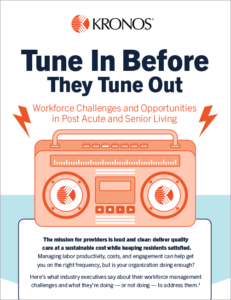Can Software Prevent Nurse Burnout?

To reduce nurse burnout and improve patient care, healthcare facilities are implementing scheduling software, which helps ensure proper nurse-to-patient ratios.
// Sponsored Post //
By Jon Forknell, Vice President and General Manager of Atlas Business Solutions
It’s no secret that nursing is a demanding profession. Long hours, highly stressful situations and the emotional toll of coping with sick patients on a regular basis can easily lead to fatigue and burnout. This phenomenon causes nurses to look for alternative career options and lends itself to the nationwide nurse shortage and retention crisis.
One major contributing factor to nurse burnout is the impact of nurse-to-patient ratio. When nurses are required to care for more patients than they have the resources for, they become frustrated, overwhelmed and exhausted. This not only adversely affects the nurse’s physical and mental health; it often results in lower-quality patient care.
Some healthcare providers recognize the direct impact staffing levels have on their nurses, as well as overall patient care and satisfaction. To ensure proper staffing numbers, many facilities are implementing nurse scheduling software. But with so many options available, how do you know which program will best meet your scheduling specifications?
Here are three things to consider when selecting the scheduling software that fits your healthcare facilities’ unique requirements.
- Does it measure up? Employee scheduling software should take manually performing staffing calculations off nurse managers, giving them more time to focus on core responsibilities. This increases productivity and ensures proper staffing levels and nurse-to-patient ratios. Whether it staffs nurses based on shift requirements, census count or by patient acuity, each healthcare facility should consider whether the software it chooses can be customized to make the required calculations according to its unique criteria.
- Does it work for 24/7 staffing and multiple locations? An employee scheduling system that is designed for facilities that schedule for shifts and operate around the clock is essential. Software that allows nurse managers to create schedules for multiple departments and provides visibility of multiple schedules across an entire organization will safeguard against double booking or improperly scheduling nurses who work in multiple departments or locations.
- Does it have your back? Tracking nurses’ skill levels, certifications and credentials is necessary for maintaining appropriate staffing levels. Software with the capability to assign these qualifications to each nurse helps managers schedule by required certifications, training and skill — ensuring the proper number of qualified nurses are scheduled in the appropriate departments. For added scheduling and compliance security, look for software that sends alerts when certifications are nearing expiration or when employees are due for additional training.
Finding the scheduling program that best meets the staffing demands of your healthcare facility will reduce the risk of nurse burnout and improve overall patient satisfaction. Additionally, it can cut time spent on scheduling by up to 75% — that’s a sound investment for any healthcare facility.

Jon Forknell is the Vice President and General Manager of Atlas Business Solutions, Inc., a software marketing company specializing in employee scheduling software, including ScheduleAnywhere, and other business software solutions. Jon has been recognized by the U.S. Small Business Administration as an SBA Young Entrepreneur of the Year.
Related Articles
Topics: Administration , Executive Leadership , Featured Articles , Staffing , Technology & IT










